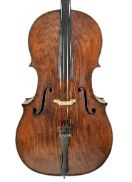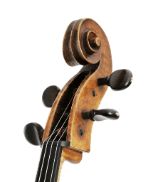Violoncello, Giovanni Battista Grancino, Milan, 1706, “ex Piatti-Dunlop”
Printed label: “Giovanni Grancino in Contrada / Largha di Milano al segno / della Corona 1706” (06 handwritten)When this violoncello was built, both 70-year-old Giovanni Battista Grancino and his son by the same name worked in a studio on Contrada Larga in Milan. The house was known by the name “al segno della Corona” (at the sign of the crown). It is impossible to tell how much of this instrument was made by the father or the son. When the instrument was built, no uniform body length standard existed yet. Most cellos were larger than is common today. As the technical demands on orchestra music grew and virtuous solo parts for strings were composed, musicians began to prefer smaller violoncellos with a body length of around 75 cm. As a consequence, many of the superb old instruments were modified to reduce body length. The Grancino cello was also cut down in this fashion. Its belly is made of three pieces, as a narrow wing was added to the middle part on the treble side. The annual rings display regular growth but are very wide. The two-piece, slab-cut back is made of unflamed maple. The instrument is highly arched, with the back arched more than the belly. The cut of the f-holes is very elegant, with perfectly round and very well-proportioned eyes. The deftly and expertly executed narrow scroll is typical of Grancino’s work. The toolmarks still clearly show the direction of the cuts. A light ground is coated with a dark-brown, finely crazed color varnish. The violoncello’s overall condition is very good. It was named after Italian cello virtuoso Alfredo Piatti (1822–1901), who spent most of his career in London. The instrument then passed into the hands of Charles B. Lutyen, who sold it to W. E. Hill & Sons. After 1900, it was played by Dutch cellist and composer Auguste van Biene. In 1931, it passed to Elizabeth Schuyler Dunlop through dealer Albert Caressa of Paris.





